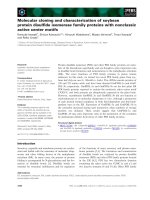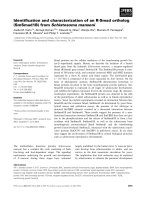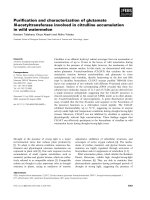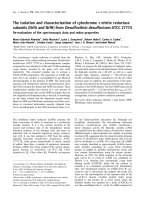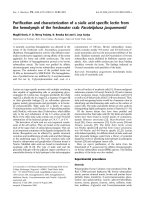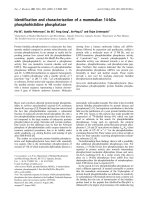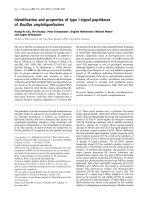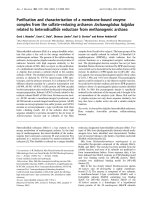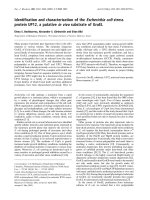Báo cáo khoa học: Identification and characterization of multiple species of tenascin-X in human serum doc
Bạn đang xem bản rút gọn của tài liệu. Xem và tải ngay bản đầy đủ của tài liệu tại đây (295.24 KB, 10 trang )
Identification and characterization of multiple species
of tenascin-X in human serum
D. F. Egging
1
, A. C. T. M. Peeters
2
, N. Grebenchtchikov
3
, A. Geurts-Moespot
3
, C. G. J. Sweep
3
,
M. den Heijer
2
and J. Schalkwijk
1
1 Department of Dermatology, Nijmegen Centre for Molecular Life Sciences, Radboud University Nijmegen Medical Centre, the Netherlands
2 Department of Endocrinology, Radboud University Nijmegen Medical Centre, the Netherlands
3 Department of Chemical Endocrinology, Radboud University Nijmegen Medical Centre, the Netherlands
Tenascin-X (TNX) is a large 450 kDa extracellular
matrix (ECM) glycoprotein composed of epidermal
growth factor (EGF)-like repeats, fibronectin type III
(FNIII) repeats and a C-terminal fibrinogen domain
(FbgX) [1–4]. A 140 kDa fragment of TNX has been
identified in human serum [5]. TNX abnormalities are
associated with several pathological conditions [5–9].
Complete TNX deficiency in humans leads to a reces-
sive form of Ehlers–Danlos syndrome (EDS) and TNX
haploinsufficiency is associated with hypermobility
type EDS [5–7]. The skin of TNX-deficient patients
reveals abnormal elastic fibres and reduced collagen
density [5,8]. TNX-deficient patients show easy bruis-
ing and some exhibit cardiovascular abnormalities,
such as mitral valve insufficiency. There are, however,
no indications for generalized cardiovascular abnor-
malities [5,10,11].
The level of TNX in serum likely reflects the level of
synthesis and or breakdown at the tissue level because
individuals heterozygous for TNX have greatly
decreased levels of serum TNX ( 50–60% of the
mean level seen in control subjects) [5,7]. Abdominal
aortic aneurysm is associated with high serum levels of
TNX, whereas TNX in abdominal aortic aneurysm tis-
sue appears reduced [9]. Matsumoto et al. [12] recently
identified a 200 kDa mouse serum TNX species prob-
ably generated by proteolytic cleavage. The biochemi-
cal properties of human serum TNX have not been
investigated in detail to date. In this study, we identi-
fied multiple TNX species and found that serum TNX
Keywords
collagen; Ehlers–Danlos syndrome; elastin;
serum; tenascin-X
Correspondence
J. Schalkwijk, Department of Dermatology,
Nijmegen Centre for Molecular Life
Sciences, Radboud University Nijmegen
Medical Centre, PO Box 9101, 6500 HB,
Nijmegen, the Netherlands
Fax: +31 24 354 1184
Tel: +31 24 3613 272
E-mail:
(Received 23 November 2006, revised 21
December 2006, accepted 29 December
2006)
doi:10.1111/j.1742-4658.2007.05671.x
We analysed the diversity of tenascin-X (TNX) species in serum and studied
parameters that could affect determination of TNX levels in serum. Using
western blot analysis we identified at least seven distinct TNX species, ran-
ging from 75 kDa to the presumably full-length 450 kDa form. Purification
of serum TNX followed by sequence analysis positively identified two major
TNX species of 75 and 140 kDa. We found that serum TNX binds to
tropoelastin but not to fibrillar collagens. We conclude that serum TNX is
composed of distinct molecular species that retain functional activity.
Abbreviations
ECM, extracellular matrix; EDS, Ehlers–Danlos syndrome; EGF, epidermal growth factor; FNIII, fibronectin type III; HIS, poly(histidine); MBP,
maltose-binding protein; TNX, tenascin-X.
1280 FEBS Journal 274 (2007) 1280–1289 ª 2007 The Authors Journal compilation ª 2007 FEBS
retains biological activity as it is able to bind to tropo-
elastin.
Results
Multiple TNX species in human serum
We have previously shown that polyclonal antibodies
raised against a C-terminal 100-kDa fragment of TNX
recognize a fragment of TNX in serum of 140 kDa
[5]. As a first approach to characterize serum TNX we
generated antibodies against nonoverlapping FNIII
repeats starting at the N-terminus of the C-terminal
100-kDa portion of TNX, as shown in Fig. 1A. Using
our new set of antisera, we found several different
TNX species in human serum (Fig. 1B). The combined
lanes 1 and 3 of Fig. 1B reveal at least seven distinct
TNX species recognized by the respective antisera.
Serum from TNX-deficient patients, which is a con-
venient control, is negative, indicating the specificity of
the antisera. Little or no cross-reaction between anti-
bodies specific for FNIII27–28 and FNIII29–30 anti-
gen and FNIII29–30 with FNIII27–28 antigen could
be detected (Fig. 1C). The molecular masses of these
seven species vary between 75 kDa and a high molecu-
lar mass form, which by extrapolation may be identical
to the full-length 450 kDa tissue form. A polyclonal
antibody raised against FNIII29–30 recognizes a TNX
species migrating at 75 kDa, which is not recognized
by a polyclonal antibody raised against FNIII27–28 of
TNX. This suggests that the N-terminus of the 75 kDa
A
B
C
D
Fig. 1. Identification and characterization of TNX species in serum.
(A) The antigens to which the TNX antibodies have been generated
are shown schematically. (B) Several species of TNX can be identi-
fied by the different antibodies in normal human serum (lanes+ ⁄ +),
serum from TNX-deficient patients is used as a negative control
(lanes – ⁄ –). Not all bands show equal signal strength if antibodies
against FNIII27–28, 29–30 and 27–32 are compared, however, with
antibodies against FNIII29–30 and 27–32 a band migrating at
75 kDa can be distinguished. This 75 kDa band is not recognized
by the FNIII27–28 antibody. The background of the antibody against
C-terminal 100 kDa TNX is relatively high, making analysis difficult.
(C) We investigated the cross-reactivity of FNIII27–28 and FNIII29–
30 antibodies against FNIII27–28, FNIII29–30 and 100 kDa C-ter-
minal TNX. Both antibodies showed little to no significant cross-
reactivity to each other’s antigens, however, they both recognized
100 kDa C-terminal TNX as strongly as their own antigens. (D)
A mAb directed against FNIII3-5 of bovine TNX detected an
N-terminal-located TNX species in normal human serum, of
200 kDa (lane 5 of the first blot, indicated by an arrowhead). This
species was absent in serum from a TNX-deficient patient (lane 6).
This N-terminal TNX species was not recognized by a mAb directed
against FNIII12–15 of bovine TNX. The FNIII12-15 antibody detected
a high molecular TNX species (lane 5 of right blot, indicated by an
arrowhead), which by extrapolation could be full-length 450 kDa
TNX. Other bands are difficult to interpret due to similar bands in
serum from TNX-deficient patients (lane 5–6 of the right blot). mAbs
against bovine TNX do not cross-react with C-terminal human FNIII
TNX repeats (lanes 1–3). Bovine TNX was used as a positive con-
trol, some degradation products can be observed (lane 4).
D. F. Egging et al. Multiple species of tenascin-X in human serum
FEBS Journal 274 (2007) 1280–1289 ª 2007 The Authors Journal compilation ª 2007 FEBS 1281
TNX fragment is located somewhere in the C-terminus
of FNIII repeat 28 or in the N-terminus of repeat 29.
The 75 kDa species is also recognized, although with
less affinity, by a polyclonal antibody raised against
FNIII27–32. Other (> 75 kDa) TNX species in serum
are also recognized by these antibodies (Fig. 1B). The
polyclonal antibody raised against 100 kDa TNX suf-
fers from a high background signal, making it difficult
to distinguish TNX species other than the 140 kDa
species that we have described previously. In our previ-
ous study the 140 kDa form migrated just below a
148 kDa marker band. Here we find, depending on the
gel type used, a molecular mass of 150 kDa (Fig. 1B,
lanes 1, 3 and 5) or slightly under 150 kDa (Fig. 1B,
lane 7). We refer to this species as the 140–150 kDa
serum form. An N-terminal-located TNX serum spe-
cies of 200 kDa was detected using an antibody
directed against FNIII3–5 of bovine TNX (Fig. 1D).
This N-terminal TNX species was not recognized by
an antibody directed against FNIII12–15 of bovine
TNX (Fig. 1D). A high molecular mass species was
detected by the FNIII12–15 antibody, other bands are
difficult to interpret due to similar bands in serum
from TNX-deficient patients. C-Terminal FNIII
repeats 27–32 were not recognized by either antibody.
Bovine TNX was used as a positive control, and some
degradation products could be observed.
The number of TNX species appeared to be the
same in 30 healthy individuals that we examined.
Because TNX may play a role in abdominal aortic
aneurysms, we examined serum TNX species in 20
patients; in one abdominal aortic aneurysm patient we
found a TNX species of a different molecular mass, as
shown in Fig. 2.
The 75 kDa serum TNX species has the approximate
molecular mass of the 74-kDa C-terminal adrenal-
specific truncated TNX protein (XB-S) [13]. We inves-
tigated serum from two patients with a bilateral
adrenalectomy and found that the 75 kDa band for
TNX was present on western blot (data not shown).
This indicates that the 75 kDa species found in blood is
not the XB-S form derived from the adrenal glands.
Amino acid sequences of TNX species in human
serum
Having identified at least seven distinct TNX species,
we subsequently tried to isolate serum TNX for further
characterization. Serum TNX was purified by affinity
chromatography and blotted onto a poly(vinylidene
difluoride) membrane. Only two TNX species were suf-
ficiently abundant to be distinguished using Coomassie
Brilliant Blue staining, migrating at 140–150 and
75 kDa (Fig. 3). Sequence coverage by MS ⁄ MS of the
75 kDa TNX species revealed peptide sequences that
align with the C-terminal part of TNX (accession num-
ber NM_019105; Fig. 4A). The exact N-terminus could
not be determined by N-terminal sequencing (Edman
type), however, the covered amino acid sequence by
MS ⁄ MS suggested a molecular mass of at least 70 kDa
(without glycosylation), which is in line with the esti-
mated molecular mass on SDS ⁄ PAGE. Sequence cov-
erage by MS ⁄ MS of the 140–150 kDa TNX species
revealed peptide sequences that align mostly with the
C-terminal part of TNX. Because of the high degree of
similarity between FNIII repeats, three peptide
sequences can be aligned on multiple positions in the
TNX sequence (Fig. 4B). Furthermore, the exact
N-terminus could not be determined by N-terminal
sequencing (Edman type), making it difficult to assess
the exact molecular mass.
Factors influencing serum TNX levels
Serum TNX levels, as determined by ELISA, have
been used as a surrogate marker to correlate tissue
Fig. 2. Alternative TNX species in one abdominal aortic aneurysm
patient. The number of TNX species appears to be the same in
most individuals (examined in 30 healthy individuals). One abdom-
inal aorta aneurysm patient of a group of 20 showed a TNX species
of a different molecular mass as indicated by the arrow.
Multiple species of tenascin-X in human serum D. F. Egging et al.
1282 FEBS Journal 274 (2007) 1280–1289 ª 2007 The Authors Journal compilation ª 2007 FEBS
TNX expression to pathology in several diseases. In
the previous section, we showed that serum TNX is
more heterogeneous than previously anticipated. As a
next step, we investigated several parameters that may
affect the apparent concentration of TNX in serum,
such as age, gender, circadian cycle, fasting ⁄ nonfasting
and the use of plasma versus serum. None of these fac-
tors, with the exception of age, was found to have a
significant effect on TNX levels determined by ELISA
(data not shown). Figure 5 shows a moderate but sig-
nificant effect of age on mean serum TNX levels, with
adults having significantly lower TNX levels than chil-
dren. We used an anova followed by posthoc testing,
analysed using our previously described sandwich
ELISA [5], similar results were obtained by an ELISA
using chicken anti-(TNX FNIII29–30) and rabbit anti-
(TNX FNIII29-30) (data not shown).
Another factor, when performing population-based
studies on serum samples is the stability of the analyte.
Although freeze–thaw cycles appear to have little effect
on TNX concentration, prolonged storage at )20 °C
results in an apparent decrease in TNX levels as deter-
mined by ELISA. TNX concentrations appear to be
stable when stored at )80 °C. We analysed a number
of samples from serum stored over longer periods and
fresh serum and found no evidence of the appearance
of additional bands after storage (data not shown).
Fig. 3. Isolation of TNX from serum. The predominant species in
TNX appear to be 140–150 and 75 kDa (indicated by arrows) after
isolation from human serum using a HIS–FNIII27–32-coupled affin-
ity column, as shown by Coomassie Brilliant Blue staining.
Fig. 4. Amino acid sequence coverage of the 75 and 140–150 kDa species. Amino acid sequences found after trypsinization and analysis by
MS ⁄ MS are underlined. Peptides found by MS ⁄ MS for the 75 kDa TNX species cover 42% of the amino acid sequence between the most N-
terminal peptide (amino acid 3654) and C-terminal peptide (amino acid 4276) and 64% for the 140–150 kDa TNX species (between amino acid
3238 and 4276) (not shown). (A) The covered peptide amino acid sequences by MS ⁄ MS suggest a molecular mass (MW) of at least 70 kDa
(without glycosylation) for the 75 kDa species. The most N-terminal peptide amino acid sequence is located near the C-terminus of FNIII28
starting at amino acid 3654. The amino acid sequences for FNIII28 and FNIII29 are designated by horizontal brackets. (B) Sequence coverage
by MS ⁄ MS of the 140–150 kDa TNX species revealed peptide amino acid sequences which align mostly with the C-terminal part of TNX.
Because of the homology between FNIII repeats three peptide sequences can be aligned on multiple positions in the TNX sequence, the
most C-terminal occurrences are marked in bold (the amino acid sequence for FNIII24 is designated by horizontal brackets).
250
200
150
100
50
0
0–5 6–15 16–18 >18
Age (years)
*
*
Percentage
Fig. 5. TNX levels measured in serum from children compared with
adults. TNX levels of children were calculated as percentages com-
pared with adults. The mean TNX concentration in serum from chil-
dren aged < 16 years is lower than that of adults (*P<0.05,
Duncan’s post hoc test, N ¼ 18 for 1–5 years, N ¼ 20 for
5–16 years, N ¼ 8 for 16–18 years and N ¼ 10 for > 18 years of
age).
D. F. Egging et al. Multiple species of tenascin-X in human serum
FEBS Journal 274 (2007) 1280–1289 ª 2007 The Authors Journal compilation ª 2007 FEBS 1283
Functional properties of serum TNX
TNX deficiency causes connective tissue disease, and it
is speculated that TNX regulates the assembly or sta-
bility of the ECM. Previous studies have shown that
TNX can bind to various ECM molecules [14–21]. We
investigated if human serum TNX could interact with
components of elastic fibres, fibrillar collagens or mat-
rix glycoproteins. To identify extracellular ligands of
TNX, we performed solid-phase assays to test the
binding of TNX purified from serum (soluble phase)
to ECM molecules (immobilized substrates). Figure 6A
shows that bovine tropoelastin (soluble phase) binds
dose dependently to serum TNX (solid phase); Fig. 6B
shows binding of serum TNX as soluble binding part-
ner to TE (solid phase). We did not detect any signifi-
cant binding to human collagen type I, III and V;
binding to human fibronectin, laminin or irrelevant
protein (BSA) was also absent (data not shown). Simi-
larly, we did not find any effect of serum TNX on col-
lagen fibrillogenesis, using an in vitro assay based on
turbidimetry [18] (data not shown).
Discussion
We previously identified a 140–150 kDa species of
TNX in human serum and used serum TNX levels to
assess the relationship between TNX expression and
disease [5,7,9,11]. Serum TNX measurement was used
to detect heterozygosity for TNX null alleles and we
found that high levels of serum TNX are a risk factor
for abdominal aortic aneurysm [5,9]. Here we demon-
strate that multiple species of TNX exist in serum,
using newly developed antibodies against FNIII27–28
and 29–30 of TNX. A polyclonal antibody against the
complete C-terminal 100 kDa portion of TNX showed
only one clear band at 140–150 kDa in our previous
study [5], although repeats FNIII27–28 and 29–30
are also present in 100 kDa TNX. Several factors
can explain this apparent discrepancy; the background
signal is quite high in the polyclonal serum against
C-terminal 100 kDa TNX, making most bands indis-
tinguishable. Furthermore, the serum samples in our
previous study were enriched for high molecular mass
proteins by ammonium sulfate precipitation, which
may have distorted the result. In this study we ana-
lysed full serum and were able to vaguely distinguish a
75 kDa TNX species using the polyclonal antiserum
against C-terminal 100 kDa TNX. The 75 kDa TNX
species was clearly distinguishable with the polyclonal
antiserum against FNIII29–30 of TNX and the signal
for the bands corresponding to the 75 and 140–
150 kDa species are approximately of equal strength.
Most likely, the FNIII29–30 repeats of TNX are not
as immunogenic as other FNIII repeats because our
newly developed polyclonal antibody against FNIII27–
32 has a higher affinity for the 140–150 kDa species
compared with the 75 kDa TNX species.
Sequence coverage by MS ⁄ MS of the affinity-purified
140–150 and 75 kDa TNX species suggests they are
C-terminal fragments of TNX. The exact N-terminus
of both TNX species could not be determined in two
separate runs using N-terminal sequencing (Edman
type). Both runs were complete blanks, instead of
multiple possible sequences as is the case in rugged
N-terminal ends, suggesting blocked N-termini. The
75 kDa species is not recognized by a polyclonal anti-
body against FNIII27–28, but is recognized by a poly-
clonal antibody against FNIII29–30. This is in line
with the sequence obtained using MS ⁄ MS, which shows
the most N-terminal part of the sequence for the
75 kDa TNX species starting in the C-terminal part of
FNIII28. Polyclonal antibodies against both FNIII27–
28 and FNIII29–30 recognize the 140–150 kDa species.
This is in line with the sequence obtained by MS ⁄ MS,
which covers all these domains. Most peptide sequences
were found covering the last 115 kDa. Because of the
large sequence similarity between FNIII repeats, some
peptide sequences can be aligned at several different
positions within the TNX sequence. Unique peptide
Fig. 6. Binding of TNX to tropoelastin. (A) Tropoelastin (soluble
phase) binds dose dependently to TNX isolated from serum (solid
phase). (B) TNX (soluble phase) isolated from serum binds to tropo-
elastin (solid phase), although saturation was not reached in the
concentration range analysed. We failed to detect binding of serum
TNX to collagen types I, III and V, fibronectin, laminin and nonsense
protein (BSA) (data not shown).
Multiple species of tenascin-X in human serum D. F. Egging et al.
1284 FEBS Journal 274 (2007) 1280–1289 ª 2007 The Authors Journal compilation ª 2007 FEBS
sequences, only aligning once within the TNX
sequence, were found in the last C-terminal 115 kDa.
These findings suggest that the 140–150 kDa TNX spe-
cies is a C-terminal fragment of full-length 450 kDa
TNX comprising the fibrinogen-like domain. Whether
the TNX species in serum are products of proteolytic
cleavage or alternative splicing is not clear. It is attract-
ive to speculate that the 75 kDa species found in
human serum is the same as the adrenal specific XB-S
short isoform [13]. The 75 kDa species however,
is found in serum from patients with bilateral
adrenalectomy making it unlikely that the 75 kDa spe-
cies in serum is derived from the adrenal glands. It
could be that XB-S is expressed in other tissues which
were not examined in the original study by Tee et al.
[13]. An N-terminal-located TNX serum species of
200 kDa was detected using an antibody directed
against FNIII3–5 of bovine TNX. This N-terminal
TNX species was not recognized by an antibody direc-
ted against FNIII12–15 of bovine TNX. The antibody
against bovine FNIII3–5 did not recognize the high
molecular mass species visible in Fig. 1B, which is pre-
sumably the full-length 450 kDa species. We speculate
that limited affinity of the anti-(bovine TNX) sera for
human TNX and the amount of this species in serum
could have precluded possible detection.
Because serum TNX may reflect TNX turnover in
tissue, it is of interest to examine the diversity of TNX
species in healthy individuals and abdominal aortic
aneurysm patients. Western blot analysis of 30 healthy
individuals showed a fairly similar pattern of TNX
species, with the major bands migrating at 75 and
140–150 kDa. In only one patient with aortic aneur-
ysm did we find a distinct pattern of TNX species. We
conclude, however, that no consistently distinct pattern
of TNX species exists in serum from these patients.
We showed that several parameters are important
when quantification of TNX serum levels is required,
such as donor age and sample storage. These parame-
ters should be taken into consideration when studying
correlations of pathological conditions and TNX levels
in serum.
Full-length TNX is present in connective tissue in
which it presumably regulates the deposition and
maintenance of structural ECM molecules such as elas-
tin and fibrillar collagens. Abnormalities of TNX are
associated with several pathological conditions in
which collagen and elastic fibre abnormalities are
observed [5–9,22]. This study indicates that serum
TNX can still bind to tropoelastin. Our finding sug-
gests that the domains relevant for binding to tropo-
elastin and regulation of elastic fibre assembly or
stability could reside in the 75 and 140–150 kDa C-ter-
minal species. The failure of serum TNX to bind to
collagen types I, III and V [18,20,21] is surprising
because we previously mapped binding of these pro-
teins to the FNIII29 of TNX in a study of C-terminal
TNX domains [20]. The recombinant TNX domains in
our previous study were produced in prokaryotic cells
[20], therefore glycosylation may influence binding of
native TNX forms. However, Minamitani et al.
showed that glycosylated mouse TNX binds to colla-
gen type I via the FNIII repeats [18]. Binding of TNX
to collagens appears quite complex, and Lethias et al.
demonstrated that deletion of the EGF repeats, fibrin-
ogen domain or both resulted in a loss of binding to
collagen type I, contradicting the results by Minami-
tani et al. [18,21]. Furthermore, Minamitani et al.
showed that deletion of either the EGF repeats or
fibrinogen domain negatively influenced the effect of
TNX on collagen fibrillogenesis, whereas they showed
that deletion of these domains did not influence bind-
ing to collagen type I [18]. We showed that the
FNIII29 of human TNX has an effect on collagen
fibrillogenesis, however, this effect was absent in
100 kDa C-terminal TNX. By contrast, 100 kDa C-ter-
minal TNX was still able to bind to bind to collagen
type I [20]. Taking all the data into account, it is feas-
ible that conformational changes imposed on these
shorter TNX species could influence binding of TNX
to collagen types I, III and V. In addition, binding of
TNX to collagen fibres could also be regulated
through other ECM molecules [15,19]. In conclusion,
our data provide novel information on serum TNX
that could be useful in future studies on the physiolo-
gical role of this intriguing extracellular matrix mole-
cule, and its role in human pathology.
Experimental procedures
Recombinant TNX protein production
and purification
TNX FNIII repeats 27–28, 29–30 and 27–32 were amplified
by PCR with the primers listed in Table 1 using a previ-
ously described 2.7 kb human TNX cDNA as a template
[23].
PCR products were ligated into the pCR2.1TOPO vector
(Invitrogen, Breda, the Netherlands) according to the
manufacturer’s instructions for easy digestion with restric-
tion enzymes. The pCR2.1 TOPO vectors with inserts were
digested with EcoRI and SalI and regions coding for
FNIII27–28 and FNIII29–30 were cloned into the EcoRI ⁄ -
SalI site of the pMal-c2X plasmid (Westburg B.V., Leus-
den, the Netherlands). The region coding for FNIII27–32
was inserted into the EcoRI ⁄ SalI site of the pET28(a)+
D. F. Egging et al. Multiple species of tenascin-X in human serum
FEBS Journal 274 (2007) 1280–1289 ª 2007 The Authors Journal compilation ª 2007 FEBS 1285
plasmid (Brunschwig Chemie B.V., Amsterdam, the Nether-
lands). The sequence of the TNX domains was verified by
dideoxy sequencing with a 3730 DNA analyser (Applied
Biosystems, Nieuwekerk a ⁄ d IJssel, the Netherlands).
TNX FNIII27–28 and 29–30 were expressed as maltose-
binding protein (MBP) fusion proteins in Escherichia coli
TOP10F¢ cells (Invitrogen). TNX FNIII27–32 was
expressed as a poly(histidine) (HIS) fusion protein in E. coli
TOP10F¢ cells. TNX FNIII27–32 was extracted from the
cell pellet using SDS extraction steps. MBP-tagged fusion
proteins were purified over amylose resin columns (West-
burg). HIS-tagged FNIII27–32 was purified over a Ni-NTA
resin column (Invitrogen). All expression and purification
steps were performed according to the manufacturer’s
instructions. All fusion proteins were analysed for purity
using SDS ⁄ PAGE.
ECM components for protein interactions
Human collagen type I was from Chemicon Interna-
tional (Temecula, CA), and human collagen types III and
V were from Rockland Inc. (Tebu-bio, Heerhugowaard, the
Netherlands). Bovine collagen type I (acid soluble) was
obtained from BD Biosciences (Alphen aan den Rijn, the
Netherlands). Recombinant bovine tropoelastin (bTE) was
a generous gift from Dr R. Mecham (Washington Univer-
sity, St Louis, MO) [24]. Human laminin was obtained
from Gibco (Life Technologies, Breda, the Netherlands).
BSA and human fibronectin were obtained from Sigma-
Aldrich (Zwijndrecht, the Netherlands). BSA was used as a
negative control.
Production of anti-TNX sera
Purified MBP–TNX FNIII27–28 and 29–30 protein was used
to immunize rabbits and chickens. Aliquots containing 10 lg
of protein in 500 lL of NaCl ⁄ P
i
were mixed with an equal
volume of Freund’s complete adjuvant for the first injection
and Freund’s incomplete adjuvant for boosters. All injections
in chickens and booster injections in rabbits were adminis-
tered subcutaneously, whereas the first injection in rabbits
was in the popliteal gland. Injections were repeated 12 times
for both chickens and rabbits at 2-week intervals. The experi-
mental design was approved by the animal use committee of
the Radboud University Nijmen. Polyclonal antibodies
against MBP–TNX FNIII27–28 and 29–30, isolated from
chicken egg yolks and citrate plasma from rabbits, were puri-
fied by affinity chromatography on HIS–TNX FNIII27–32
coupled AffiGelÒ15 columns (Bio-Rad Laboratories B.V.,
Veenendaal, the Netherlands) according to previously des-
cribed procedures [25,26].
Purified HIS–TNX FNIII27–32 protein was used for
immunization of a rabbit. Aliquots of 500 lg HIS–TNX
FNIII27–32 in 500 lL of NaCl ⁄ P
i
were mixed with an
equal volume of Freund’s complete adjuvant for the first
injection and Freund’s incomplete adjuvant for boosters.
Three injections were administered subcutaneously at
3-week intervals. Polyclonal antibodies against HIS–TNX
FNIII27–32, isolated from serum, were purified by affinity
chromatography on HIS–TNX FNIII27–32 couples to
CNBr-activated Sepharose 4B column (GE Healthcare Life
Sciences, Diegem, Belgium). Filtered (0.2 lm sterile filter;
Schleider & Schuell, Dassel, Germany) 1 : 5 NaCl ⁄ P
i
-
diluted serum was loaded onto the column. The column
was washed with 200 column volumes of NaCl ⁄ P
i
and
eluted with 0.1 m glycine–HCl (pH 2.7). Protein-containing
fractions were pH neutralized with 1 m Tris ⁄ HCl (pH 9.5).
Affinity-purified rabbit and guinea-pig antibodies raised
against a C-terminal 100 kDa fragment of TNX used in this
study have been described previously [5,6]. Bovine TNX and
monoclonal antibodies against FNIII3–5 and FNIII12–15 of
bovine TNX were generously provided by Dr C. Lethias
(Institut de Biologie et Chimie des Prote
´
ines, Lyon, France).
TNX ELISA
TNX concentrations were measured in a sandwich ELISA
described previously [5] or in a new ELISA incorporating
four different antibodies [25]. Briefly, the new assay for-
mat incorporated four different antibodies: duck anti-
(chicken IgY) sera; chicken anti-(TNX FNIII27–28) or
anti-(FNIII29–30) sera; rabbit anti-(TNX FNIII27–28) or
anti-(FNIII29–30) sera; and goat anti-(rabbit IgG) labelled
with biotin. Microtitre plates (96-well Nunc Maxisorb
TM
flat-bottomed plates, eBioscience, San Diego, CA) were
coated with duck anti-(chicken IgY) (3.2 mgÆL
)1
in
50 mmolÆL
)1
NaHCO
3
⁄ Na
2
CO
3
, pH 9.6) overnight at 4 °C.
All further incubation steps were performed at 37 °C. After
each incubation step, wells were washed with NaCl ⁄ P
i
con-
taining 0.05% Tween-20 (T-NaCl ⁄ P
i
). Wells were saturated
with 1% BSA in T-NaCl ⁄ P
i
for 2 h and then incubated
with chicken anti-TNX sera for 2 h. This was followed by
Table 1. TNX domains and primers. The EcoRI and SalI site are underlined in each primer sequence. Each SalI site is preceded by a stop
codon (TCA).
TNX domains Forward primer (5¢-to3¢) Reverse primer (5¢-to3¢)
FNIII27-28 G
GAATTCGAGCTACCTCCCCAC CTCGTCGACTCACTGACCAGCAGGAGC
FNIII29-30 TCA
GAATTCTCAAGGCCCCGCCTG GAAGTCGACTCAAGGCTCACTCTCCTC
FNIII27-32 G
GAATTCGAGCTACCTCCCCAC CAGGTCGACTCAGGTGAAAGAGGTGGA
Multiple species of tenascin-X in human serum D. F. Egging et al.
1286 FEBS Journal 274 (2007) 1280–1289 ª 2007 The Authors Journal compilation ª 2007 FEBS
incubation with the calibrator (His–TNX FNIII27–32),
serum samples and reference samples for 2 h. Thereafter,
wells were subsequently incubated with rabbit anti-TNX
and biotinylated anti-rabbit IgG (Vector Laboratories Inc.,
Burlingame, CA). Thereafter, wells were incubated with the
streptavidin ⁄ b-galactosidase conjugate (Roche Diagnostics
Nederland B.V., Almere, the Netherlands) for 2 h followed
by incubation with 4-methylumbelliferyl-b-d-galactopyr-
anoside conjugate (Sigma-Aldrich) in substrate buffer
(100 mmolÆL
)1
KH
2
PO
4
⁄ K
2
HPO
4
and 1 mmolÆL
)1
MgCl
2
,
pH 7.4) for 1 h. The reaction was stopped by the addi-
tion of 50 mmolÆL
)1
NaHCO
3
⁄ Na
2
CO
3
(pH 10.5), and
fluorescence was measured with a fluorometric plate reader
(Fluoroskan; MTX Laboratory Systems Inc., Vienna, VA)
using 355 nm excitation and 460 nm emission filters. All
antibodies, sera and TNX proteins were diluted in
T-NaCl ⁄ P
i
containing 1% BSA.
Cross-reactivity of antibodies with antigens
Cross-reactivity was tested using a solid phase assay.
Recombinant TNX was coated onto microtitre plates
(96-well Nunc Maxisorb
TM
flat-bottomed plates; eBio-
science) overnight at 4 °C. All further incubation steps were
performed at 37 °C. Wells were saturated with T-NaCl ⁄ P
i
containing 1% BSA and subsequently incubated with rabbit
anti-(TNX FNIII27–28) or anti-(TNX FNIII29–30) sera.
Detection was performed with horseradish peroxidase-
linked anti-rabbit IgG (Cell Signalling, Berverly, MA) and
TMB substrate (Perbio Science Nederland B.V., Etten-
Leur, the Netherlands). The reaction was stopped with 4 m
H
2
SO
4
, absorbance was read at 450 nm.
Protein-binding assays
Protein interactions were measured in a solid phase assay
with ECM components bound to a microtitre plate (solid
phase) followed by incubation with serum TNX (soluble
phase). Ninety-six-well microtitre plates (Greiner Bio-One
B.V., Alphen aan den Rijn, the Netherlands) were coated
overnight at 4 °C with ECM components, or with BSA as
a control, diluted in NaCl ⁄ P
i
. All further incubation steps
were performed at 37 °C. After each incubation step, wells
were washed with T–NaCl ⁄ P
i
. Wells were saturated with
1% BSA in T-NaCl ⁄ P
i
for 2 h and then incubated with
serum TNX for 1 h. This was followed by incubation
with rabbit anti-(TNX FNIII29–30) serum for 1 h. There-
after, wells were incubated with biotinylated anti-rab-
bit IgG (Vector Laboratories) for 1 h followed by a 45 min
incubation with an avidin–biotin–horseradish peroxidase
mixture (vectastain kit; Brunschwig Chemie, Amsterdam,
the Netherlands). Bound peroxidase was detected with
o-phenylenediamine dihydrochloride (Perbio Science) and
the absorbance read at 490 nm. All antibodies and TNX
proteins were diluted in T-NaCl ⁄ P
i
containing 0.1% BSA.
Binding of TE to serum TNX was performed as described
above. Briefly, serum TNX was coated onto microtitre plates
(96-well Nunc Maxisorb
TM
flat-bottomed plates; eBio-
science) overnight at 4 °C. All further incubation steps were
performed at 37 °C. Wells were saturated with T-NaCl ⁄ P
i
containing 1% BSA and subsequently incubated with various
concentrations of TE. This was followed by incubation with
a rabbit anti-TE serum (cat. no. 324756; Merck Biosciences,
Nottingham, UK). Detection was performed with horserad-
ish peroxidase-linked anti-rabbit IgG (Cell Signaling) and
TMB substrate (Perbio Science). The reaction was stopped
with 4 m H
2
SO
4
, absorbance was read at 450 nm.
Human serum and plasma collection and storage
We collected blood samples from 27 healthy volunteers (13
males and 14 females, median age 33 years, range
25–51 years). Nonfasting blood samples were drawn from
an anticubital vein in 9 mL EDTA- and 9 mL dry vacuum
glass tubes (BD Vacutainer Systems, Plymouth, UK). The
EDTA tubes were placed on ice immediately and the dry
tubes were kept at room temperature. Both tubes were cen-
trifuged at 3500 g for 10 min within 30 min (Hettich Zentri-
fugen, type 4319 centrifuge, swing-out rotor 001559). Plasma
and serum samples were stored at )20 °C (< 2 months). We
also collected samples at 00:00 and 17:00 from five persons.
From these same five persons we also collected a 09:00 fast-
ing plasma and serum sample. Serum from previously
described obligate TNX deficient- and heterozygous patients
[5,7,8,22] and serum from matched healthy individuals
stored at )20 °C was used to validate the specificity of the
ELISA. An additional 217 samples from healthy individuals
or patients with aortic aneurysm, stored at )20 °Cor
)80 °C were used for analyses of age, storage conditions or
western blot analysis. In all experiments controls were
matched for age and storage condition of samples. Informed
consent was obtained from patients and volunteers, and the
local ethics committee approved all study protocols.
SDS ⁄ PAGE and western blot
Proteins were loaded onto 12% Bis-Tris gels (Invitrogen)
and gel electrophoresis was carried out using the NuPAGE
system according to the manufacturer’s instructions (Invi-
trogen). Gels were stained using Coomassie Brilliant Blue
R250 (Brunschwig Chemie) to analyse protein purity.
Immunologic detection of proteins by western blot was
performed essentially as described previously [5], with the
exception that serum was not ammonium sulfate precipita-
ted. Serum samples were diluted 20-fold and loaded onto
12% Bis-Tris gels (Invitrogen). The rabbit polyclonal anti-
bodies against TNX FNIII27–28, 29–30 and 27–32 were
used to detect TNX fragments in a 100-fold dilution,
whereas rabbit polyclonal antibody against C-terminal
100 kDa TNX was used in a 1000-fold dilution. The
D. F. Egging et al. Multiple species of tenascin-X in human serum
FEBS Journal 274 (2007) 1280–1289 ª 2007 The Authors Journal compilation ª 2007 FEBS 1287
secondary antibodies (conjugated to biotin) against rabbit
(Brunschwig Chemie) and antibiotin antibodies (conjugated
to horseradish peroxidase) (Sigma-Aldrich) were diluted
1000-fold followed by detection with the chemiluminescent
substrate lumiGLO (Cell Signaling).
Isolation of serum TNX
TNX species were purified from serum from healthy indi-
viduals using affinity chromatography on a column with
polyclonal antibodies against HIS–TNX FNIII27–32 cou-
pled to CNBr-activated Sepharose 4B (GE Healthcare Life
Sciences). Briefly, filtered (0.2 lm sterile filter; Schleider &
Schuell) 1 : 5 NaCl ⁄ P
i
-diluted serum was loaded onto the
column. The column was washed with 500 column volumes
NaCl ⁄ P
i
and TNX species were eluted with 0.1 m glycine–
HCl (pH 2.7). Protein containing fractions were neutralized
with 1 m Tris ⁄ HCl (pH 9.5).
Protein sequencing
Affinity-purified serum TNX was blotted onto a poly(viny-
lidene difluoride) membrane (Sigma-Aldrich) and stained
using Coomassie Brilliant Blue R250 (Brunschwig Chemie)
to reveal protein bands. Bands were excised and analysed
by N-terminal sequencing (Edman type) or MS ⁄ MS.
Sequence coverage of the isolated TNX fragments was ana-
lysed by MS ⁄ MS. Briefly, isolated TNX fragments were re-
dissolved and digested with trypsin into small peptides. The
amino sequence of the peptides was determined by a mass
spectrophotometer composed of a linear ion trap mass
spectrometer (LTQ) and a Fourier Transform Ion Cyclo-
tron Resonance (FT-ICR) mass spectrometer (FTMS)
(Thermo Electron Breda, NL).
Acknowledgements
We are grateful to Wendy Pluk of the proteomics facil-
ity of the Radboud University Medical Centre for her
assistance in the MS ⁄ MS measurements. Tom Broekel-
mann and Bob Mecham of the Department of Cell
Biology and Physiology of the Washington University
School of Medicine are acknowledged for performing
N-terminal sequencing and providing recombinant
tropoelastin. Claire Lethias of the Institut de Biologie
et Chimie des Prote
´
ines is acknowledged for providing
bovine TNX and antibodies.
References
1 Bristow J, Tee MK, Gitelman SE, Mellon SH & Miller
WL (1993) Tenascin-X: a novel extracellular matrix
protein encoded by the human XB gene overlapping
P450c21B. J Cell Biol 122, 265–278.
2 Lethias C, Descollonges Y, Boutillon MM & Garrone
R (1996) Flexilin: a new extracellular matrix glycopro-
tein localized on collagen fibrils. Matrix Biol 15, 11–19.
3 Elefteriou F, Exposito JY, Garrone R & Lethias C
(1997) Characterization of the bovine tenascin-X. J Biol
Chem 272, 22866–22874.
4 Ikuta T, Sogawa N, Ariga H, Ikemura T & Matsumoto
K (1998) Structural analysis of mouse tenascin-X: evolu-
tionary aspects of reduplication of FNIII repeats in the
tenascin gene family. Gene 217, 1–13.
5 Schalkwijk J, Zweers MC, Steijlen PM, Dean WB,
Taylor G, Van Vlijmen IM, van Haren B, Miller WL &
Bristow J (2001) A recessive form of the Ehlers–Danlos
syndrome caused by tenascin-X deficiency. N Engl
J Med 345, 1167–1175.
6 Burch GH, Gong Y, Liu W, Dettman RW, Curry CJ,
Smith L, Miller WL & Bristow J (1997) Tenascin-X
deficiency is associated with Ehlers–Danlos syndrome.
Nat Genet 17, 104–108.
7 Zweers MC, Bristow J, Steijlen PM, Dean WB,
Hamel BC, Otero M, Kucharekova M, Boezeman JB &
Schalkwijk J (2003) Haploinsufficiency of TNXB is
associated with hypermobility type of Ehlers–Danlos
syndrome. Am J Hum Genet 73, 214–217.
8 Zweers MC, Vlijmen-Willems IM, Van Kuppevelt TH,
Mecham RP, Steijlen PM, Bristow J & Schalkwijk J (2004)
Deficiency of tenascin-X causes abnormalities in
dermal elastic fiber morphology. J Invest Dermatol 122,
885–891.
9 Zweers MC, Peeters AC, Graafsma S, Kranendonk S,
van Vlijmen I, den Heijer M & Schalkwijk J (2006)
Abdominal aortic aneurysm is associated with high
serum levels of tenascin-X and decreased aneurysmal
tissue tenascin-X. Circulation 113, 1702–1707.
10 Peeters ACTM, Kucharekova M, Timmermans J,
van den Berkmortel FWPJ, Boers GH, Novakova IRO,
Egging D, den Heijer M & Schalkwijk J (2004) A clini-
cal and cardiovascular survey of Ehlers–Danlos syn-
drome patients with complete deficiency of tenascin-X.
Neth J Med 62, 23–25.
11 Lindor NM & Bristow J (2005) Tenascin-X deficiency
in autosomal recessive Ehlers–Danlos syndrome. Am
J Med Genet A 135, 75–80.
12 Matsumoto K, Kinoshita T, Hirose T & Ariga H (2006)
Characterization of mouse serum tenascin-X. DNA Cell
Biol 25, 448–456.
13 Tee MK, Thomson AA, Bristow J & Miller WL (1995)
Sequences promoting the transcription of the human
XA gene overlapping P450c21A correctly predict the
presence of a novel, adrenal-specific, truncated form of
tenascin-X. Genomics 28, 171–178.
14 Elefteriou F, Exposito JY, Garrone R & Lethias C
(1999) Cell adhesion to tenascin-X mapping of cell
adhesion sites and identification of integrin receptors.
Eur J Biochem 263, 840–848.
Multiple species of tenascin-X in human serum D. F. Egging et al.
1288 FEBS Journal 274 (2007) 1280–1289 ª 2007 The Authors Journal compilation ª 2007 FEBS
15 Elefteriou F, Exposito J, Garrone R & Lethias C (2001)
Binding of tenascin-X to decorin. FEBS Lett 495, 44–47.
16 Lethias C, Elefteriou F, Parsiegla G, Exposito JY &
Garrone R (2001) Identification and characterization of
a conformational heparin-binding site involving two
fibronectin type III modules of bovine tenascin-X.
J Biol Chem 276, 16432–16438.
17 Matsumoto K, Saga Y, Ikemura T, Sakakura T & Chi-
quet ER (1994) The distribution of tenascin-X is distinct
and often reciprocal to that of tenascin-C. J Cell Biol
125, 483–493.
18 Minamitani T, Ikuta T, Saito Y, Takebe G, Sato M,
Sawa H, Nishimura T, Nakamura F, Takahashi K,
Ariga H et al. (2004) Modulation of collagen fibrillo-
genesis by tenascin-X and type VI collagen. Exp Cell
Res 298, 305–315.
19 Veit G, Hansen U, Keene DR, Bruckner P, Chiquet-
Ehrismann R, Chiquet M & Koch M (2006) Collagen
XII interacts with avian tenascin-X through its NC3
domain. J Biol Chem 281, 27461–27470.
20 Egging D, van den Berkmortel F, Taylor G, Bristow J
& Schalkwijk J (2007) Interactions of human tenascin-X
domains with dermal extracellular matrix molecules.
Arch Dermatol Res 298, 389–396.
21 Lethias C, Carisey A, Comte J, Cluzel C & Exposito JY
(2006) A model of tenascin-X integration within the
collagenous network. FEBS Lett 580, 6281–6285.
22 Zweers MC, Dean WB, Van Kuppevelt TH, Bristow J
& Schalkwijk J (2005) Elastic fiber abnormalities in
hypermobility type Ehlers–Danlos syndrome patients
with tenascin-X mutations. Clin Genet 67, 330–334.
23 Morel Y, Bristow J, Gitelman SE & Miller WL (1989)
Transcript encoded on the opposite strand of the human
steroid 21-hydroxylase ⁄ complement component C4 gene
locus. Proc Natl Acad Sci USA 86, 6582–6586.
24 Kozel BA, Wachi H, Davis EC & Mecham RP
(2003) Domains in tropoelastin that mediate elastin
deposition in vitro and in vivo. J Biol Chem 278,
18491–18498.
25 Grebenschikov N, Geurts-Moespot A, de Witte H,
Heuvel J, Leake R, Sweep F & Benraad T (1997) A
sensitive and robust assay for urokinase and tissue-type
plasminogen activators (uPA and tPA) and their
inhibitor type I (PAI-1) in breast tumor cytosols. Int J
Biol Markers 12, 6–14.
26 Grebenchtchikov N, Sweep CG, Geurts-Moespot A,
Piffanelli A, Foekens JA & Benraad TJ (2002) An
ELISA avoiding interference by heterophilic antibodies
in the measurement of components of the plasminogen
activation system in blood. J Immunol Methods 268,
219–231.
Supplementary material
The following supplementary material is available
online:
Fig. S1. Amino acid sequence coverage of the 75 and
140-150 kDa species. (Figure expanded from Fig. 4.)
This material is available as part of the online article
from
Please note: Blackwell Publishing is not responsible
for the content or functionality of any supplementary
materials supplied by the authors. Any queries (other
than missing material) should be directed to the corres-
ponding author for the article.
D. F. Egging et al. Multiple species of tenascin-X in human serum
FEBS Journal 274 (2007) 1280–1289 ª 2007 The Authors Journal compilation ª 2007 FEBS 1289

